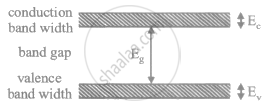Advertisements
Advertisements
Question
Estimate the proportion of boron impurity which will increase the conductivity of a pure silicon sample by a factor of 100. Assume that each boron atom creates a hole and the concentration of holes in pure silicon at the same temperature is 7 × 1015 holes per cubic metre. Density of silicon 5 × 1028 atoms per cubic metre.
Solution
Initially, the total number of charge carriers per cubic metre is given by
ni = 2 × 7 × 1015
\[\Rightarrow\] ni = 14 × 1015
Finally, the total number of charge carriers per cubic metre is given by
nf = 14 × 1017/m3
We know that the product of the concentrations of holes and conduction electrons remains almost the same.
Let x be the number of holes.
Thus,
\[(7 \times {10}^{15} ) \times (7 \times {10}^{15} ) = x \times (14 \times {10}^{17} - x)\]
\[ \Rightarrow 14x \times {10}^{17} - x^2 = 49 \times {10}^{30} \]
\[ \Rightarrow x^2 - 14x \times {10}^{17} - 49 \times {10}^{30} = 0\]
\[ \Rightarrow x = \frac{14 \times {10}^{17} \pm \sqrt{(14 )^2 \times {10}^{34} + 4 \times 49 \times {10}^{30}}}{2}\]
\[ \Rightarrow x = \frac{14 \times {10}^{17} \pm \sqrt{(14 )^2 \times {10}^{34} + 4 \times 49 \times {10}^{30}}}{2}\]
\[ \Rightarrow x = \frac{28 . 0007}{2} \times {10}^{17} = 14 . 00035 \times {10}^{17}\]
This is equal to the increased number of holes or the number of atoms of boron added.
Number of atoms of boron added = \[(14 . 00035 \times {10}^{17} - 7 \times {10}^{15} ) = 1386 . 035 \times {10}^{15}\]
Now, 1386.035 × 1015 atoms are added per 5 × 1028 atoms of Si in 1 m3.
Therefore, 1 atom of boron is added per \[\frac{5 \times {10}^{28}}{1386 . 035 \times {10}^{15}}\] atoms of Si in 1 m3.
Proportion of boron impurity is \[3 . 607 \times {10}^{- 3} \times {10}^{13} = 3 . 607 \times {10}^{10}\]
APPEARS IN
RELATED QUESTIONS
Distinguish between a conductor and a semi conductor on the basis of energy band diagram
Distinguish between a metal and an insulator on the basis of energy band diagrams ?
We have valence electrons and conduction electrons in a semiconductor. Do we also have 'valence holes' and 'conduction holes'?
When an impurity is doped into an intrinsic semiconductor, the conductivity of the semiconductor
The electrical conductivity of pure germanium can be increased by
(a) increasing the temperature
(b) doping acceptor impurities
(c) doping donor impurities
(d) irradiating ultraviolet light on it.
A semiconductor is doped with a donor impurity.
Calculate the number of states per cubic metre of sodium in 3s band. The density of sodium is 1013 kgm−3. How many of them are empty?
The band gap between the valence and the conduction bands in zinc oxide (ZnO) is 3.2 eV. Suppose an electron in the conduction band combines with a hole in the valence band and the excess energy is released in the form of electromagnetic radiation. Find the maximum wavelength that can be emitted in this process.
The product of the hole concentration and the conduction electron concentration turns out to be independent of the amount of any impurity doped. The concentration of conduction electrons in germanium is 6 × 1019 per cubic metref conduction electrons increases to 2 × 1023 per cubic metre. Find the concentration of the holes in the doped germanium.. When some phosphorus impurity is doped into a germanium sample, the concentration o
The conductivity of an intrinsic semiconductor depends on temperature as σ = σ0e−ΔE/2kT, where σ0 is a constant. Find the temperature at which the conductivity of an intrinsic germanium semiconductor will be double of its value at T = 300 K. Assume that the gap for germanium is 0.650 eV and remains constant as the temperature is increased.
(Use Planck constant h = 4.14 × 10-15 eV-s, Boltzmann constant k = 8·62 × 10-5 eV/K.)
A semiconducting material has a band gap of 1 eV. Acceptor impurities are doped into it which create acceptor levels 1 meV above the valence band. Assume that the transition from one energy level to the other is almost forbidden if kT is less than 1/50 of the energy gap. Also if kT is more than twice the gap, the upper levels have maximum population. The temperature of the semiconductor is increased from 0 K. The concentration of the holes increases with temperature and after a certain temperature it becomes approximately constant. As the temperature is further increased, the hole concentration again starts increasing at a certain temperature. Find the order of the temperature range in which the hole concentration remains approximately constant.
(Use Planck constant h = 4.14 × 10-15 eV-s, Boltzmann constant k = 8·62 × 10-5 eV/K.)
With reference to Semiconductor Physics,
Draw a labelled energy band diagram for a semiconductor.
What is forbidden band?
If the lattice constant of this semiconductor is decreased, then which of the following is correct?

A hole in a. p – type semiconductor is
A semiconductor is cooled from T.K to T2K its resistance will
In a semiconductor, the forbidden energy gap between the valence, band and the conduction band is of the order of
The energy required by an electron to jump the forbidden band in silicon at room temperature is about ______.
Which one of the following elements will require the highest energy to take out an electron from them?
Pb, Ge, C and Si
